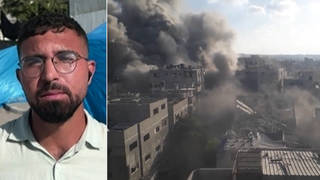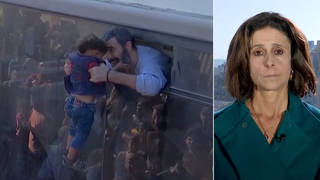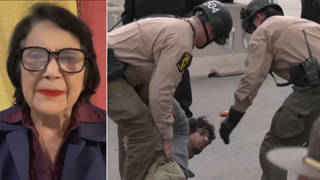
Topics
Guests
- Nicolette WaldmanAmnesty International researcher specializing in detention issues. She is the co-author of the new report, “Human Slaughterhouse: Mass Hangings and Extermination at Saydnaya Prison, Syria.”
Amnesty International has released a shocking report claiming as many as 13,000 people—mostly civilians—have been hanged in a Syrian government military prison in recent years. Amnesty accuses the Assad government of running a human slaughterhouse and engaging in a deliberate policy of extermination by hanging thousands of civilians at a prison near Damascus. Amnesty says the killings amount to war crimes and crimes against humanity. We speak to the co-author of the report, Nicolette Waldman, an Amnesty International researcher specializing in detention issues.
Transcript
NERMEEN SHAIKH: Amnesty International has released a shocking report claiming as many as 13,000 people, mostly civilians, have been hanged in a Syrian government military prison in recent years. Amnesty accuses the Assad government of running a human slaughterhouse and engaging in a “deliberate policy of extermination” by hanging thousands of civilians at a prison near Damascus. Amnesty says the killings amount to war crimes and crimes against humanity. Earlier this week, Amnesty released a video describing how they uncovered the mass killings.
AMNESTY INTERNATIONAL VIDEO: Since 2011, tens of thousands of people have disappeared into a vast network of prisons and detention centers run by the Syrian government. Many have been taken to Saydnaya, a notorious and terrifying prison where detainees are incarcerated in horrific conditions, systematically and brutally tortured. Thousands have died in confinement. Inaccessible to journalists and independent monitoring groups, the prison is a black hole, of which no recent images exist. The memories of those who survive it are the only available resource with which to understand what happens within Saydnaya.
In April 2016, Amnesty International and Forensic Architecture traveled to Turkey to meet a group of Saydnaya survivors. We used architectural and acoustic modeling to reconstruct the prison and their experiences of detention. Because the prisoners were held in darkness and under a brutally enforced silence, their memories depend on an acute experience of sound—footsteps, doors opening and locking, water dripping in the pipes. All of these sounds structured detainees’ experiences of space and time, and forebode what was to come. Based on these testimonies, we have constructed a model of the entire prison and located the witness testimonies and the sounds they recall within it. These testimonies are traumatic recollections and are rarely straightforward descriptions of events. In Saydnaya, the architecture of the prison emerges not only as a location of torture, but itself as an instrument in its perpetration.
NERMEEN SHAIKH: The Syrian Justice Ministry has rejected Amnesty International’s finding, issuing a statement saying, quote, “The justice ministry denies and condemns in the strongest terms what was reported because it is not based on correct evidence but on personal emotions that aim to achieve well-known political goals.”
Amnesty’s report, titled “Human Slaughterhouse,” was published on Tuesday, less than two weeks after President Trump signed an executive order banning refugees indefinitely and temporarily barring entry to all citizens from Syria and six other Muslim-majority nations. It also comes as Fox News is reporting Russia has just sent Syria the largest shipment of missiles between the two countries to date.
AMY GOODMAN: We go now to London, where we’re joined by Nicolette Waldman, an Amnesty International researcher specializing in detention issues. She’s the co-author of Amnesty’s new report. The title is chilling, the information inside even more so. “Human Slaughterhouse.” Nicolette, tell us what you found.
NICOLETTE WALDMAN: Over the course of a year of research, we found that the Syrian authorities are carrying out a calculated campaign of mass hangings and extermination at Saydnaya prison. Every week, and often twice a week, prisoners are taken out of their cells and brought to another prison, another building on the grounds of the prison, where they’re hanged to death. And since 2011, as many as 13,000 people have been hanged. As the backdrop to this, detainees are held in horrific conditions. And the Syrian authorities have been deliberately inflicting repeated torture, as well as the systematic deprivation of food, water, medicine and medical care, which has caused a massive number of deaths.
NERMEEN SHAIKH: Nicolette, can you give us a sense of how many people are detained in Saydnaya and how many similar prisons there are across Syria?
NICOLETTE WALDMAN: What we’ve been told is that between 10,000 and 20,000 detainees are held in Saydnaya at any given time. But I want to point out that it’s very difficult to know exactly how many, because the government releases no evidence, no information on the whereabouts of the people that they arrest. And, in fact, almost every detainee arrested by the Syrian authorities is disappeared, meaning that they’re cut off from their friends, their families and the outside world.
In terms of the other detention facilities in Syria, there is a vast network of centers that we know about and centers that we do not know about. So, this is a very large system that has processed tens of thousands of people since 2011, in particular. And since that time, as many as 17,700 people have died as a result of this—these extermination policies, which is the result of repeated torture and terrible conditions. So, the 17,700 deaths is even in addition to these as many as 13,000 people who have been hanged at Saydnaya prison.
AMY GOODMAN: I want to turn to a short animated video produced by Amnesty International. The script is extrapolated from the experiences of prisoners interviewed by Amnesty.
PRISONER: Why aren’t we leaving? Why are we being taken to solitary cells? It’s so cramped. It’s OK. Soon, we will be in a better place. I can’t take these new beatings. It has never been so bad. Are we really being transferred, or is this our last punishment? We are on the move. We stopped. Why? We’re in another building. They grab my finger. They’re taking my fingerprints. What? I can’t believe it! They tell me I’ve been condemned to death, and ask if I have any last wish. I have done nothing wrong. They said I was being transferred. I’m supposed to be transferred. Dear God, protect my family.
AMY GOODMAN: The animation ends with the hanging of the man. That video ends with the words: “As many as 13,000 people have been executed in Saydnaya since 2011.” Our guest, Nicolette Waldman, co-author of the Amnesty report. Can you tell us, Nicolette, how you got this information, how you collected this information from prisoners and also from guards?
NICOLETTE WALDMAN: What we did for this report is that we carried out the research over the course of 12 months, so from December 2015 to December 2016. And in that time, we interviewed 84 witnesses. These witnesses included former detainees who had witnessed different steps of the execution process. And we also identified former guards and officials at the prison. As well, we interviewed former judges and Syrian lawyers. And with all of the information we received, which was oftentimes collected after two or three or more interviews with each witness to evaluate the veracity and the consistency of what they were saying, we were able to corroborate, cross-check and finally build up a step-by-step picture of what is happening at Saydnaya.
Now, most of these interviews were carried out in southern Turkey and in other areas in Turkey, as well as remotely with witnesses in Lebanon, Jordan, the U.S. and Europe. And we were forced to actually conduct this research outside of Syria, because we have been barred from entering government-controlled areas since 2011. We’ve also been barred, along with almost every international monitoring group, from entering the prisons in Syria. So, what’s important to remember is that these are really black holes of war crimes and crimes against humanity, where crimes have been taking place on a widespread, systematic and continual basis since 2011. And the main crimes against humanity that are being committed—again, these are crimes against humanity, some of the most serious international crimes that you could ever imagine. But just at Saydnaya, the crimes against humanity that are being carried out since 2011 are murder, disappearance, torture and extermination. So these are massive violations that we’re really pushing the world to take notice of and to take action.
NERMEEN SHAIKH: Nicolette, as you mentioned, you also spoke to prison guards, former prison guards. Now, that prison was run by Syrian military personnel. How did you get them to speak to you? And what did they say about why they were working at this prison?
NICOLETTE WALDMAN: So, to identify the guards, we ended up taking, again, a very long and arduous process of using local contacts, civil society organizations, our own contacts—basically, a network of people—to help us identify these people, because we felt that these findings were so significant and so weighty that we needed to have not only the witness testimony, but also people from the inside. And what they told us about why they conducted these crimes is really—is not something that we talked about. Instead, we were trying to get the information.
However, what is clear to me is that this is not a system that is carried out by one person or another. This is a top-down system, where very—it’s very much controlled through the highest levels of the Syrian government and the Syrian political establishment. And what we found about these policies of mass hangings and extermination is that they come from the very top, and that, actually, the very farcical death sentences that are issued to the prisoners are signed by the minister of defense, who is deputized to act for President Assad, and that the hangings themselves, which take place in the middle of the night and in total secrecy, are overseen by a panel of men which include top-level security force officers, as well as top officials from the prison and, as well, from Tishreen Military Hospital, where the prisoners are taken by the truckload after they are hanged, to be registered before they are taken on to mass graves.
NERMEEN SHAIKH: Now, the Assad regime, as you’ve pointed out, does not talk about this prison. It’s more or less concealed from view. But the Assad regime has, of course, been accused of some of the worst atrocities against its civilian population, and that occurs mostly in broad daylight.
NICOLETTE WALDMAN: Yeah.
NERMEEN SHAIKH: Now, you say what’s going on in this prison is more sinister. Why is that?
NICOLETTE WALDMAN: It’s absolutely sinister. And I think that’s the exact right word to use, because not only are these hangings taking place, again, on a routine basis, weekly or twice a week, but the conditions in which these prisoners are held are just very difficult to comprehend. But we have to try. And basically, what we’ve been told, through very consistent testimony—I heard the same things again and again—is that prisoners are actually routinely beaten. They are also not allowed to make any sound. So even when they are tortured, they cannot make a sound. And they are punished if they do, with further beatings. They are also forced to pick somebody in the cell, who then must dole out the punishment or the torture each day. And they’re also, what we’ve been told, forced to rape each other. The prisoners, especially the older prisoners, will be forced to rape sometimes the younger prisoners. And what we were told by one witness is that after these rapes, the men are so traumatized that they even stop eating, and they just can’t carry on.
But in these very sadistic and just horrible rules, the prisoners are also being subjected to the systematic deprivation of food, water, medicine and medical care. So they’re dying horrific deaths of thirst, of hunger, of diseases, and then treatable infections. All of what they’re going through is treatable. And this is why it’s—we are calling this the crime against humanity of extermination, which is a particular crime in the Rome Statute which refers to when a state actually inflicts conditions on a certain sector of a population and with the intent of destroying that population. And what we found is that the Syrian authorities aim to destroy the people that they have in their custody.
And finally, I want to point out that these people, the vast majority of them, are civilians. Some of their most common profiles are long-term political dissidents. They’re human rights defenders. They’re journalists. They’re humanitarian aid activists. And sometimes they have just people who went to one or two protests. So these are people who went out and basically spoke and demanded a freer and fairer society in Syria, and for that, they are paying the ultimate price.












Media Options